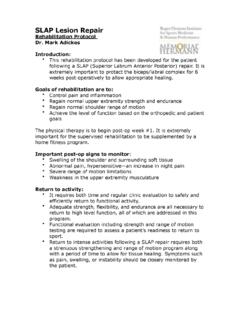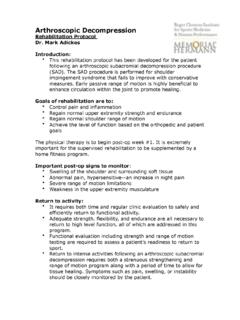Transcription of Meniscus Repair Rehabilitation Protocol - Mark …
1 Meniscus Repair Rehabilitation Protocol Dr. Mark Adickes Introduction: This Rehabilitation Protocol was developed for patients who have isolated meniscal repairs. Depending upon the complexity of the tear and location of the Repair , the weight bearing status post- operatively as well as the progression of Rehabilitation will vary. Goals of Rehabilitation are to: Control joint pain, swelling, hemarthrosis Regain normal knee range of motion Regain a normal gait pattern Regain normal lower extremity strength Regain normal proprioception, balance, and coordination The physical therapy is to begin post-op day #3-5. It is extremely important for the supervised Rehabilitation to be supplemented by a home fitness program. Important post-op signs to monitor: Swelling of the knee or surrounding soft tissue Abnormal pain response, hypersensitive Abnormal gait pattern, with or without assistive device Limited range of motion Weakness in the lower extremity musculature Return to activity: It requires both time and regular clinic evaluation to safely and efficiently return to functional activity.
2 Adequate strength, flexibility, and endurance are all necessary to return to high level function, all of which are addressed in this program. Isokinetic testing and functional evaluation are required to assess a patient's readiness to return to sport. Return to intense activities such as impact loading, jogging, deep knee flexion, or pivoting and shifting early post-operatively may increase the overall chance of a repeat meniscal tear and symptoms of pain, swelling, or instability should be closely monitored by the patient. Dr. Mark Adickes Phase 1: Week 1-2. Range of Motion: Passive, 0-90 . Patellar mobs Ankle pumps Gastroc/soleus stretch Hamstring/ITB stretch Prone hangs to facilitate extension Strength: Quad sets with E-stim/biofeedback SLR in 4 planes SAQ. Multi-hip machine in 4 planes Hip flexion-seated Multi-angle isometrics (0-60 ). Weight Bearing: Toe touch weight bearing in brace, locked in full extension with crutches Modalities: E-stim/biofeedback as needed Ice 15-20 minutes with 0 knee ext Brace: Remove brace to perform ROM activities Brace with crutches Brace locked at 0 ext to protect Repair Goals for Phase 1: Control pain, inflammation, and effusion Adequate quad/VMO contraction Independent in HEP.
3 TDWB to PWB as noted by Dr. Adickes Dr. Mark Adickes Phase 2: Week 2-4. Range of Motion: Passive, 0-120 . Patellar mobs Gastroc/soleus stretch Hamstring/quad/ITB stretch Prone hang as needed Heel/wall slides to reach goal Strength: Quad sets with biofeedback SLR in 4 planes with ankle weight Multi-angle isometrics (0-60 ). Knee extension (90-30 ). Heel raises/Toe raises Leg Press (110-40 ). Wall squats Balance Training: Weight shift (side/side, fwd/bkwd). Single leg balance Cup walk/Hesitation walk Weight Bearing: PWB to FWB with crutches as tolerated Dependent upon Dr. Adickes Bicycle: May initiate bike when 110 flex is reached DO NOT use bike to increase flexion Modalities: Biofeedback as needed Ice 15-20 minutes Brace: WBAT in brace Opened to 30 at wk 2, 60 at wk3, 90 at wk 4. Opened to full ROM at wk 5. Goals for Phase 2: ROM 0-120 . Adequate quad/VMO contraction Control pain, inflammation, and effusion PWB to FWB with quad control Dr.
4 Mark Adickes Phase 3: Week 4-12. Range of Motion: Passive, 0-135 (full). Gastroc/soleus stretch Hamstring/quad/ITB stretch Prone hang to reach goal as needed Patellar mobs Strength: Bicycle/EFX. SLR in 4 planes with ankle weight/tubing Mini-squats/Wall squats Knee extension (90-30 ). Hamstring curl (0-90 ). Leg Press-single legged eccentric Smith Press-double legged Isokinetic training at high speeds (180-360 /sec). Multi-hip machine in 4 planes Lateral/Forward step-up/down Heel raise/Toe raise Lunges-knee not to migrate over toe Balance Training: Single leg balance with plyotoss Sports cord agility work Wobble board work Foam roller work Weight Bearing: FWB by wk 4. Brace: As needed at wk 6. Modalities: Ice 15-20 minutes as needed Goals for Phase 3: ROM 0-135 . Full weight bearing Control pain, inflammation, effusion Increase lower extremity strength and endurance Enhance proprioception, balance, and coordination Complete readiness for sport specific activity Dr.
5 Mark Adickes Phase 4: Week 12-36. Range of Motion: Continue all stretching activities Strength: Continue all exercises from previous phases Running Program: Water walking Swimming (kicking). Backward run Cutting Program: Lateral shuffle Carioca, figure 8's Functional Training: Initiate light plyometric program o box hops, level, double-leg Sport specific drills Modalities: Ice 15-20 minutes as needed Goals for Phase 4: Enhance neuromuscular control Progress skill training Perform selected sports specific activity-unrestricted sporting activity Achieve maximal strength and endurance Advanced weight training and sports specific drills are advised to maintain a higher level of competition. Isokinetic testing at 6 and 12. months may be recommended to guarantee maintenance of strength and endurance.








